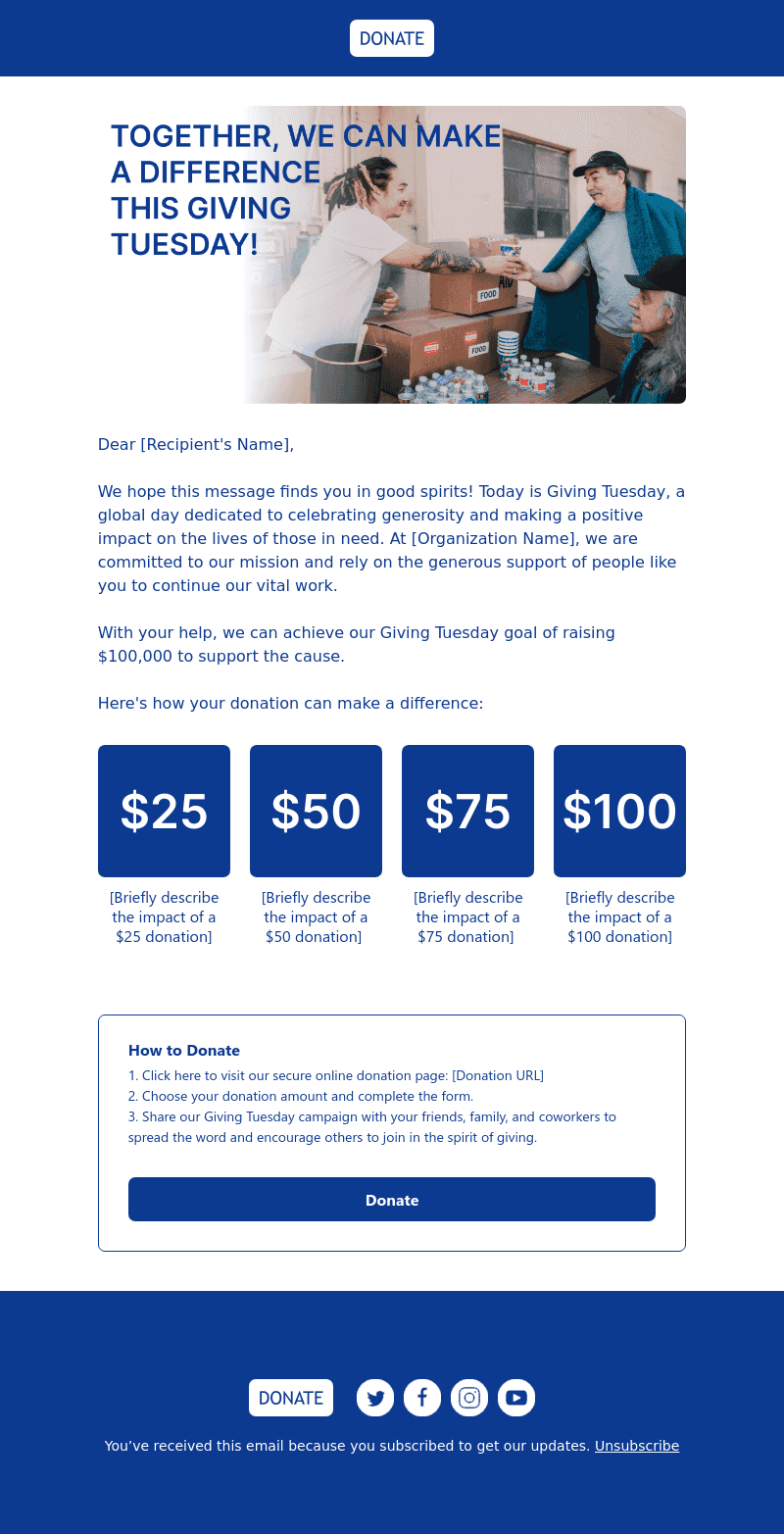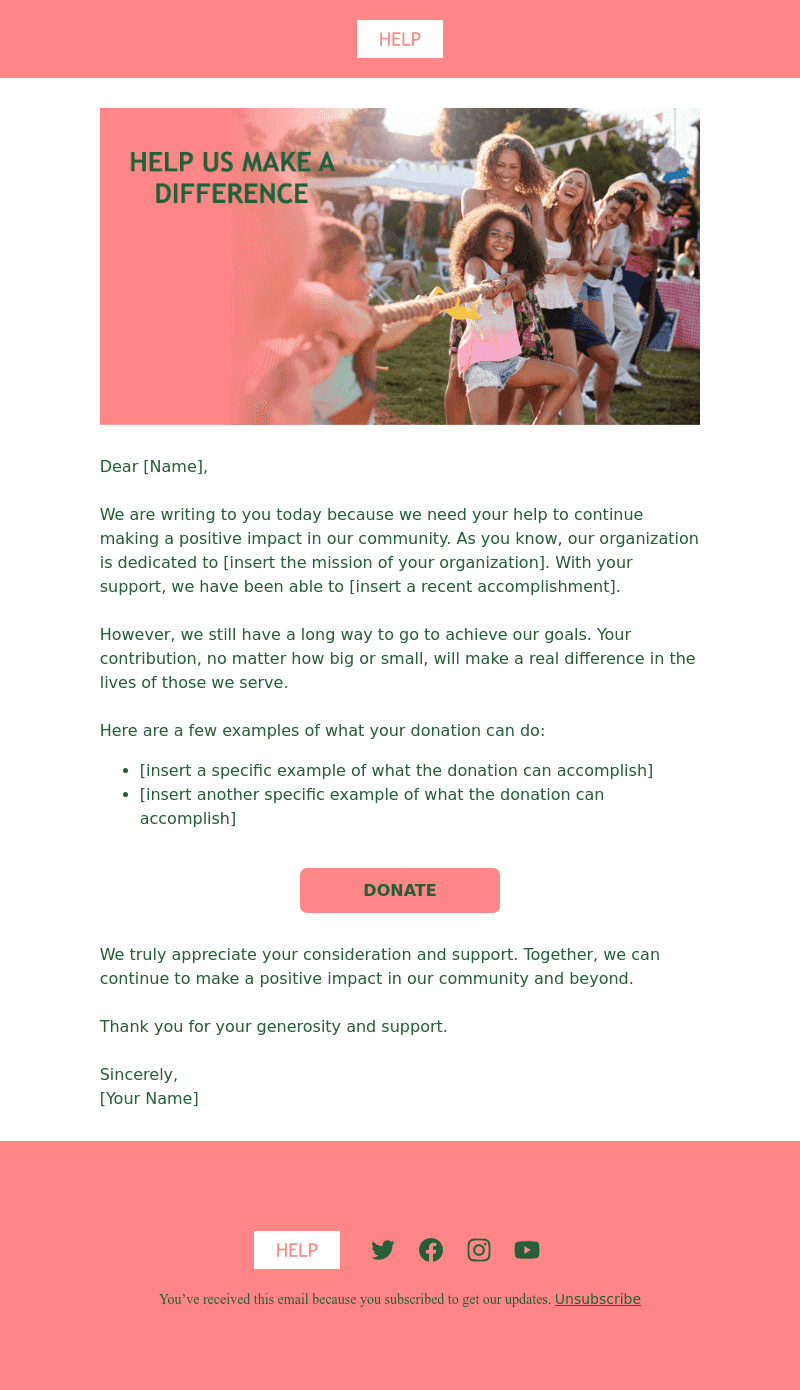Fundraising Email Campaigns: Dos, Don’ts & Key Insights
Ready to change the world, one email campaign at a time?
Fundraising emails provide more than just a way to raise money. With thoughtful strategy and execution, they gain the power to ignite passions and turn one-time donors into steady champions of your fundraising appeals.
In this article, we’ll provide a toolkit of practical tips, strategies, and real-world examples to help your campaigns reach their full potential.
Design your fundraising emails with Blocks!
Sign up now to craft your effective templates fast & easy.
9 Best Practices for Fundraising Emails
Without wasting any time, let’s examine 9 key practices that will spark enthusiasm and assist you in turning your fundraising emails into visible impact!

Show Tangible Outcomes of Fundraising Efforts
When donors witness the actual results of their endeavors, every act of kindness becomes even more fulfilling. Share clear, specific examples of how their contributions make a difference to build trust and inspire continued support.
Here are 2 effective ways to showcase tangible impact in a fundraising email:
- Get specific with results. Skip the generic phrases and vague statements in favor of evident fundraising goals with measurable data. Details such as “Every $25 provides 3 meals for a family in need” work much more effectively than an abstract “We raise funds to help fight hunger”.
- Share real-life cases. Highlight past campaigns and key achievements to illustrate the impact of donor contributions. For instance, design your fundraising campaign to show that “This year, you helped us deliver 10,000 meals to families in our community”.
As an example, take a look at this email by Everlane that shows exactly how the donated funds help the U.S. farmers.

Tap Into Emotions
Around 90% of decisions people make are influenced by emotions rather than rationality. And in fundraising emails, emotional appeal becomes a force that goes beyond simple donation requests.
Immerse readers in your message using sensory details about the positive outcomes that your work brings. For instance, describe how reaching the fundraising goal can change the lives of people for the better. A campaign that tugs at the heartstrings creates a personal connection with existing and potential donors, making them feel truly invested.
Here’s an excellent email by Charity Water that shows an effective example of how to build emotional connections during fundraising events.
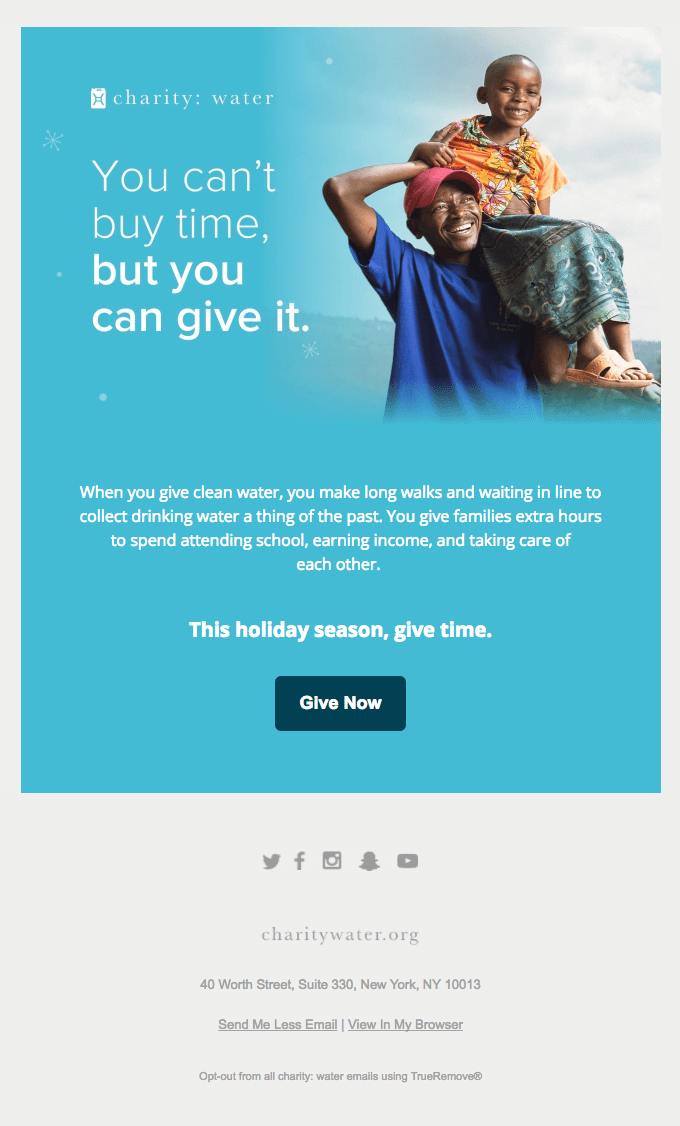
Align with a Special Occasion
Tie your fundraising email with a holiday season or event to elevate the sentiments of the moment and amplify the emotions. A well-timed seasonal message can resonate deeply by tapping into what your audience already cares about.
For instance:
- During public holidays, use the spirit of giving to inspire generosity through messages such as “This Christmas, bring joy to those in need”.
- During the back-to-school season, focus on creating an opportunity to support children: “Help kids start the school year with the supplies they require”.
- On Giving Tuesday, leverage the global movement of giving, exactly how Too Faced Cosmetics did with this fundraising email tied directly to the occasion.
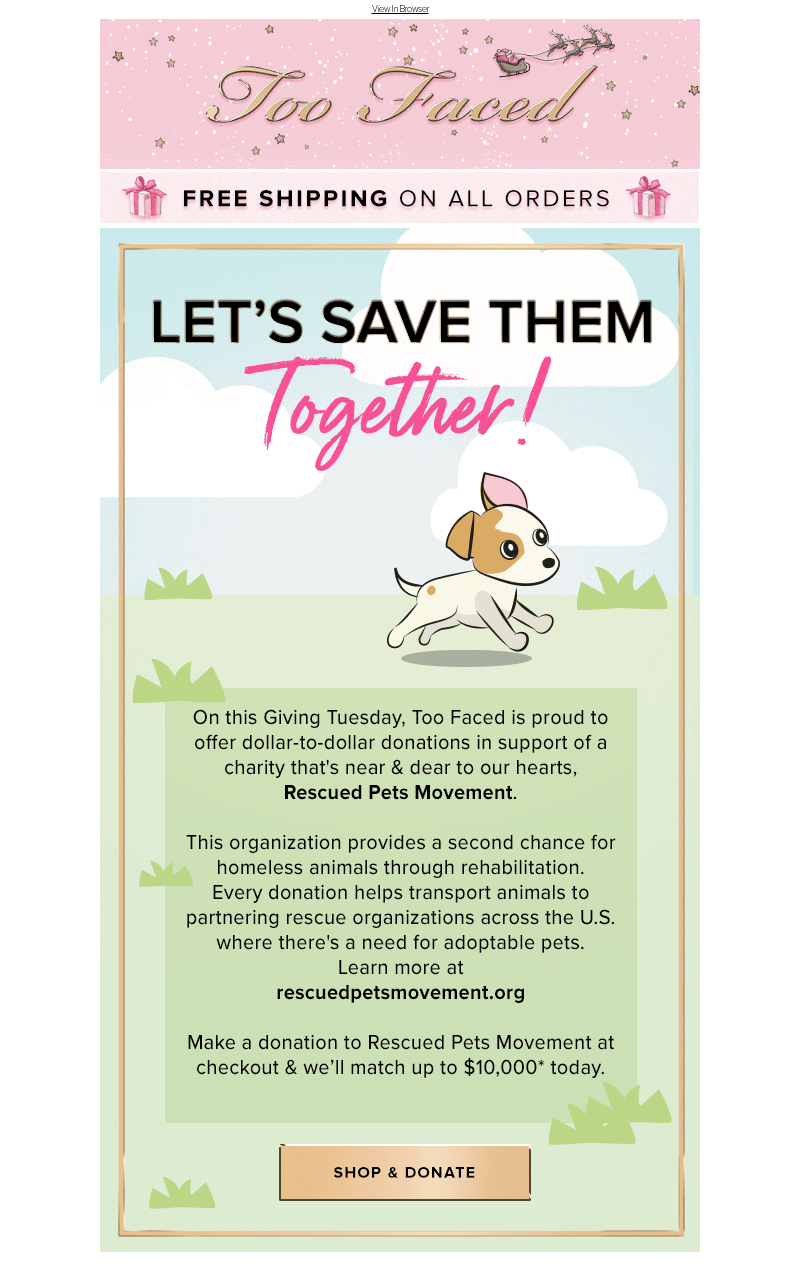
Put Focus on the Donor
Want to truly connect with the readers? Shift the focus from your organization and put donors in the spotlight! Make each contributor feel like the hero who saves the day and show how meaningful their participation is to cultivate a stronger sense of pride and responsibility toward your cause.
Reinforce this approach with inclusive language and phrases like “together, we can…” or “your ongoing support allows us to…”. For example, instead of “We need $50,000 to expand our shelter”, reframe the message as “Your donations can provide safe, warm spaces for 50 abandoned animals”.
As an illustration, here’s a fantastic email by CARE Australia that directly thanks the donors for their previous contributions.

Use Visual Storytelling
Studies show that emails with images have a 42% higher click-through rate compared to text-only ones. Visuals breathe energy into an email marketing campaign. A heartfelt photo, an engaging GIF, or a powerful video can convey emotions and create connections that words alone simply can’t.
Here are some ways to use visuals effectively in a fundraising email:
- Show before-and-after images, like a renovated community center funded by donations or the people you’ve helped, paired with their words of thanks.
- Include a behind-the-scenes clip of your team in action, working tirelessly to help those in need.
- Combine photos and videos with infographics to break down data on the funds raised and allocated.
One of the best fundraising email examples here comes from Charity Water. The campaign features a video about a 6-year-old girl who donated her savings to charity and encourages the recipients to follow her lead.
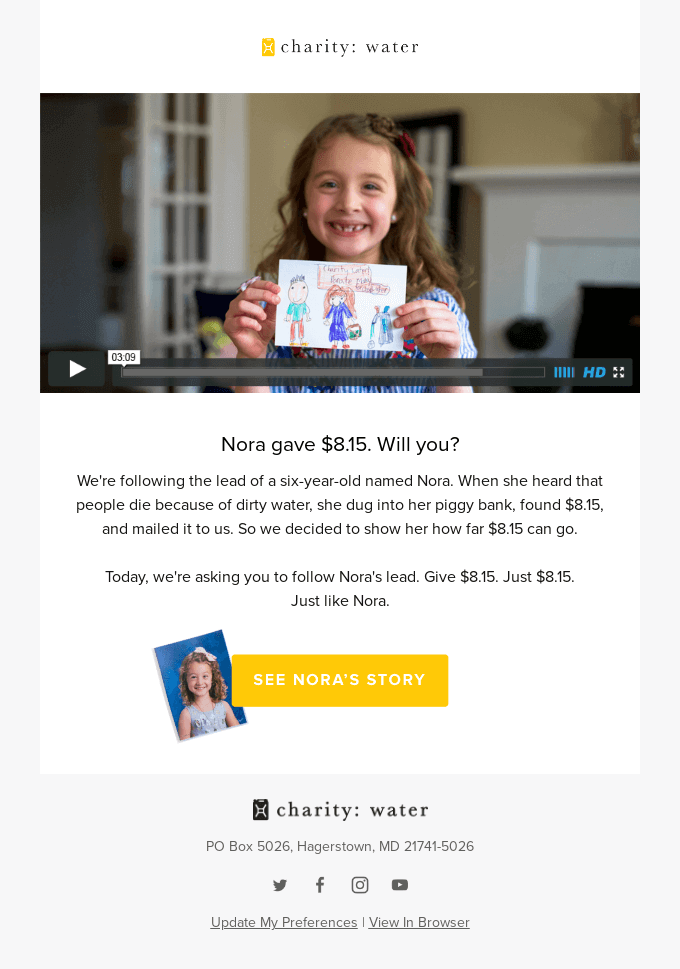
Design a Clear Call-to-Action (CTA)
A single fundraising campaign should revolve around one primary goal, and the call-to-action should make that focus unmistakable. Concentrate on a direct action that tells your audience exactly what to do, such as “Give Now” or “Donate Today”.
Make your CTA impossible to miss by using bold, contrasting colors that instantly draw attention. Position it strategically depending on the length of your email: place buttons after the opening paragraph, in the middle of your email, or after the final sentence. This ensures that the CTA remains visible regardless of where the reader stops scrolling.
For a visual example, take a look at this email by Vans that features a bright red “Donate Now” button.
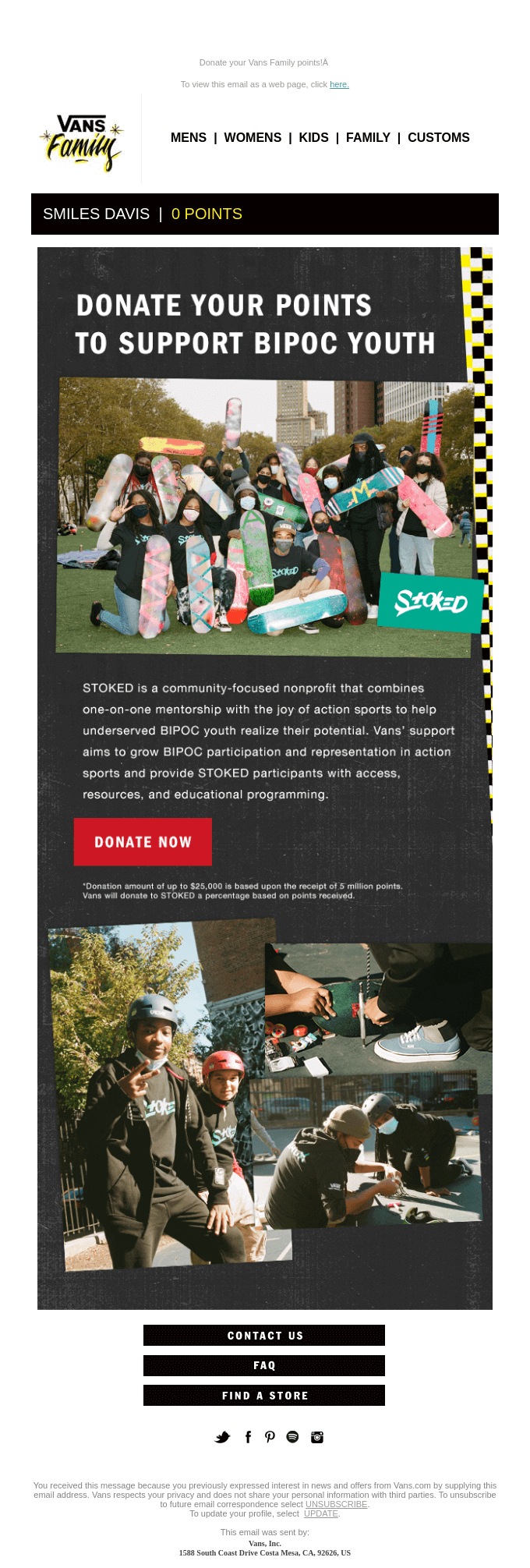
Streamline the Donation Process
One of the biggest barriers to a successful fundraising event is a donation procedure that feels complicated or cumbersome. Make sure the entire process is smooth and intuitive so that the donors can participate in your campaign with ease and comfort:
- Start your fundraising email with a clear and prominent button that leads directly to a donation page tailored to the specific campaign.
- Remove any unnecessary actions to ensure that donors can complete their contributions with minimal effort.
- Offer a variety of payment options, such as credit cards, PayPal, and mobile payment, to accommodate different preferences and needs.
Looking to promote your upcoming fundraising event but also want to save time and resources? Fundraising email templates by Blocks will give you a perfect head start! Add your elements and make edits fast and easy — even if you’ve never designed emails before!
Need a running start for your campaign?
Check out 150+ highly customizable templates in our gallery!
Keep the Email Clear & Easy to Skim Through
An email filled with dense text may overwhelm the recipients even before they reach your call-to-action. But how to avoid that if your fundraising campaign is primarily text-focused and doesn’t contain much imagery?
It’s simple: focus on delivering your message in short, impactful segments that are easy to digest!
Boost readability with formatting and visual cues that guide the reader’s eye. Break up the content with subheadings to create distinct sections, and leverage bullet points to spotlight key details. Generous white space between paragraphs helps create a clean and inviting look, ensuring the message feels approachable.
Here, Road Scholar shows how to make even a lengthy email easy to read.
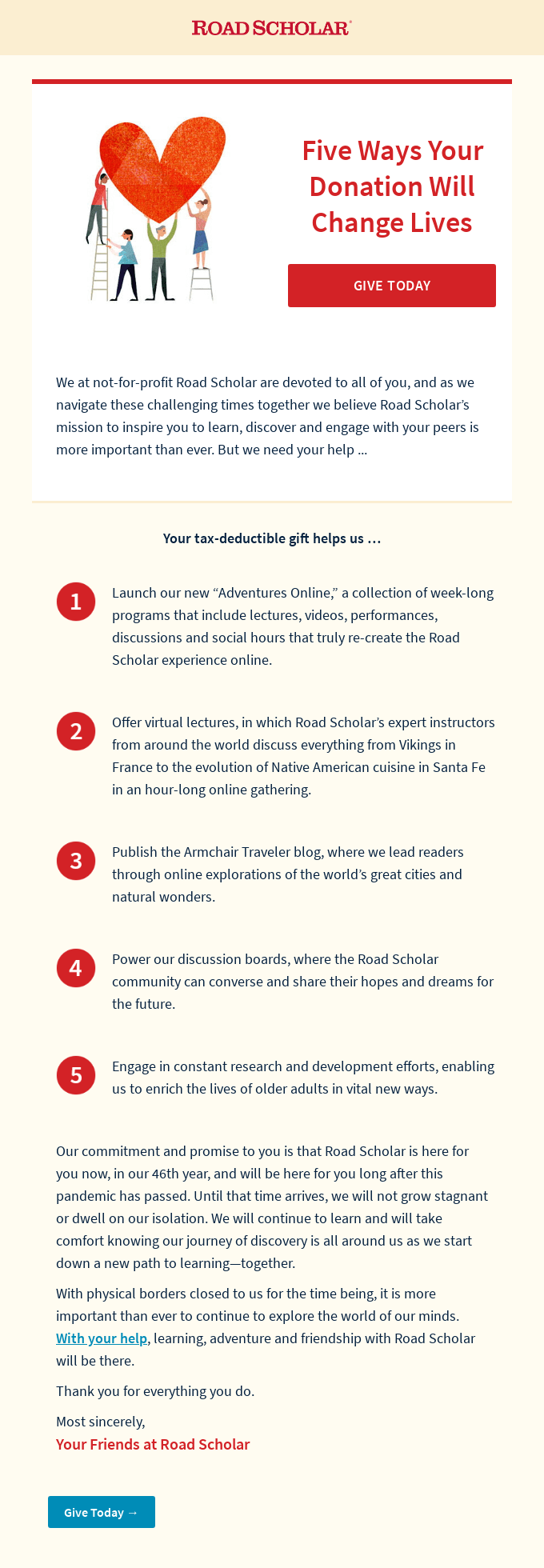
Show Gratitude with Meaningful Symbolic Gifts
A small token of gratitude can leave a lasting impression on donors and make them feel valued and appreciated. These gestures don’t need to be grand: what truly matters is their meaning and alignment with your cause.
- For smaller contributions, offer heartfelt, personalized tokens, such as a thank-you follow-up email featuring a digital certificate that donors can treasure.
- For larger donations, consider tangible gifts tied to your mission. A handmade souvenir, a reusable tote bag, or a calendar showcasing beneficiary stories can serve as a meaningful reminder of the difference the donor has made.
As an example, this email by Pura Vida Bracelets offers a special bracelet, the proceeds from which go straight to charity.
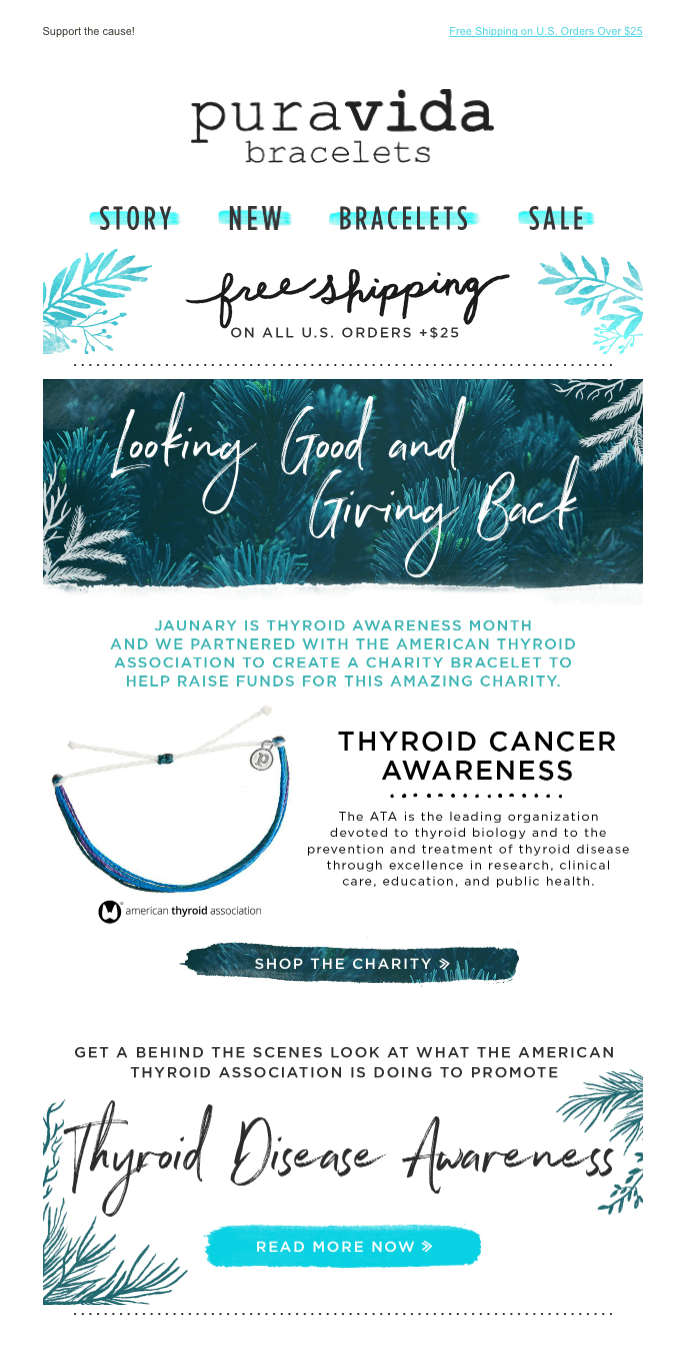
5 Helpful Tips for Fundraising Email Subject Lines
A subject line is like a neon sign for effective email communication. It’s the first chance to stand out and draw gazes in a sea of overflowing inboxes.
Ready to turn your fundraising email subject line into a spark that lights up your campaign? These 5 tips, combined with ready-to-use examples, are at your service!
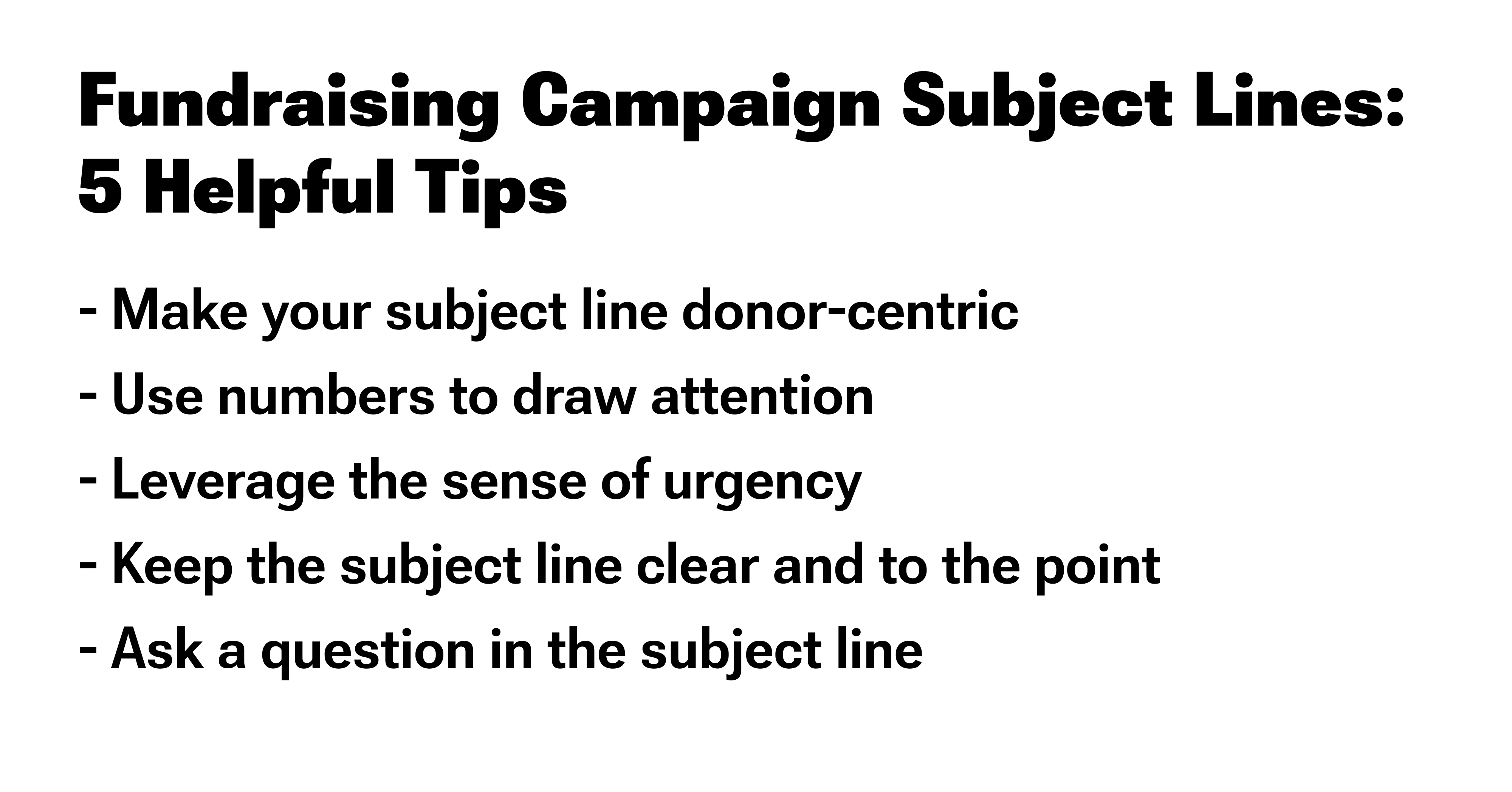
Craft a Donor-Centric Subject Line
Let the subject line talk directly to email recipients. Second-person language like “You” and “Your” builds instant connection and provides extra reason to engage with your email.
And if you already have an active donor base, include the recipient’s name for a significant impact: it’s the equivalent of saying “Hey, this one’s just for you!”.
Donor-centric subject lines you may steal:
- Sarah, your kindness today brings smiles tomorrow
- Together, we can create change — starting with you
- John, you can become a hero to those in need
Use Numbers
Numbers in subject lines act as eye-catching anchors that grab interest and paint a picture of your mission. For example, “Just $10 can change a life for the better” is more than a donation request: it’s a concrete and powerful promise of real transformation.
Number-driven subject lines you may steal:
- Your $1 could be the start of something big
- 5,000 meals provided — all thanks to you!
- Join 2,000 donors making a difference today!
Add a Sprinkle of Urgency
Infuse your subject line with a time-sensitive impulse and encourage donors to make their contribution as soon as possible. Phrases like “act now” or specific deadlines combined with numbers can trigger a sense of urgency and motivate readers to prioritize your email.
Urgent subject lines you may steal:
- Every dollar counts — just 3 days left to donate!
- Hurry! Together, we can reach the goal by midnight!
- We’re $1,000 away! Can you help us make an impact?
Be Clear and Transparent
Trust fosters action, and clarity is the bridge that gets donors there! Avoid vagueness that may leave your audience confused; instead, make your subject lines concise and to the point. This can be done through clear fundraising goals or straightforward language that underlines how meaningful the cause actually is.
Clear and transparent subject lines you may steal:
- See how your donations help families across the world
- Your gift today builds a classroom for 50 kids
- Every dollar helps provide clean water — learn more now!
Pose a Question
How much potential does a question have in a subject line? It’s a double win: a well-crafted question can make the readers pause their scroll and trigger curiosity that’s hard to resist. The key here is to ask relevant questions that directly engage your audience’s emotions, leaving them eager to discover more.
Engaging subject line questions you may steal:
- What impact will you create with $10?
- Will you help us reach 500 children this winter?
- Are you the hero we need this Giving Tuesday?
4 Common Mistakes to Avoid in Fundraising Emails
Even the most well-meaning campaigns may fall short if they stumble into pitfalls. For the final step, check out these 4 most common mistakes and learn how you can prevent them.
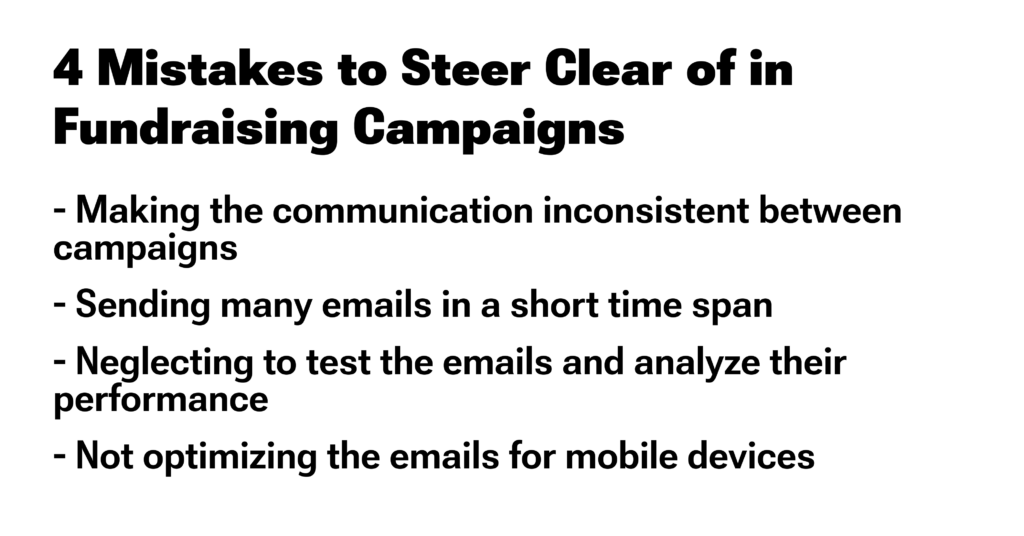
Inconsistent Messaging
Inconsistency in email communications is disorienting and can reduce donor engagement. Imagine receiving a formal appeal from a charity one day and a humorous, emoji-filled email the next. Such jarring shifts in tone may leave the recipients questioning the organization’s professionalism and authenticity.
How to maintain consistency across campaigns?
- Develop a style guide outlining your organization’s branding, tone, language, and messaging principles.
- Stick to a unified campaign narrative across all emails, ensuring the theme and goals are clear and steady.
- Align messaging across different channels (social media, email, website) so that donors see a cohesive effort, regardless of how they engage with your organization.
Sending Too Many Emails
Picture this: a donor checks their inbox and sees 3 emails from your organization, all within a single day. Even if the cause is truly important, this barrage of messages might irritate recipients and make your campaign feel less impactful. Worst of all, such over-communication may even lead to unsubscribes and diminish your reputation.
How to avoid overwhelming your audience?
- Prioritize quality over quantity. Every email should have a clear purpose, such as to raise awareness or reach out for support.
- Set a clear frequency. For example, limit emails to one per week for regular newsletters, and increase their quantity for time-sensitive seasonal campaigns.
- Use segmentation to send targeted emails only to relevant recipients. For the general audience, avoid communications that may not apply to all donors.
Neglecting to Test and Analyze Your Fundraising Campaign
Launching a campaign without tests or analysis is like navigating without a map. With no factual data at hand, you’ll be left guessing what works and what doesn’t. At the same time, poorly performing elements may lead to missed opportunities and lower engagement.
How to refine your email marketing approach?
- Conduct A/B testing to compare variations of key elements like subject lines, CTA buttons, or visuals.
- Analyze performance metrics such as open and click-through rates, conversions, and unsubscribes. Use these insights to identify patterns and improve future campaigns.
- Continuously experiment with timing, length, and formatting to discover what resonates most with your audience.
Lack of Mobile Optimization
Failure to optimize for mobile can be a dealbreaker for many recipients who read emails on smartphones. Clunky layouts, unreadable text, or slow-loading images may lead to higher bounce rates, losing both your audience’s attention and their support.
How to ensure mobile compatibility?
- Use a clean and responsive design with a single-column layout to adapt your email for different screen sizes and make it easy to scroll through on a mobile device.
- Keep subject lines short and impactful (not exceeding 30-40 characters) to fit within mobile preview limits.
- Test your emails on multiple devices and email clients to check their performance and fix any existing errors before the campaign goes live.
- Use Blocks to craft your campaigns! With our builder, you can instantly preview how your emails adapt to different screen sizes and make any necessary edits for both desktop and mobile versions.
Conclusion
With the tips and examples shared in this article, you’re ready to craft fundraising emails that drive meaningful change. From compelling subject lines to engaging visuals and a powerful message, every detail can make a difference.
So now, it’s time to roll up your sleeves: the next great campaign is just an email away. Wish you luck!
